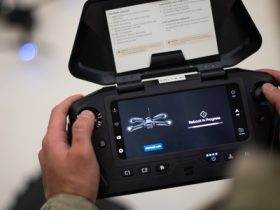The Air Force picked longtime defense IT contractor Leidos to develop and manage the guts of the service’s next-gen command, control, and communications network Defense One has learned.
The $303 million contract covers “planning, analysis, and operations” for the digital infrastructure network of the Air Force’s Advanced Battle Management System—a key component of the service’s contribution to the Pentagon’s connect-everything effort, called Joint All-Domain Command and Control, or JADC2. The Air Force also recently announced plans to bring more industry partners in to ABMS experiments.
The Air Force’s program executive office for command, control, communications and battle management runs point on ABMS and has been expanding its use of cloud-based command and control tools as part of its overall digital infrastructure plans for operators to improve battlefield communication.
But the contract, which runs for three years with an option for two more, puts Leidos as the lead for stitching technologies together for ABMS’ Digital Infrastructure Network.
Defense One spoke with Chad Haferbier, who leads Leidos’ multi-domain solutions division, to understand more about this largely classified initiative. He said the first order of business is sitting down with Air Force leadership to understand “what they want to field, and how we can help them do that, and how we want to organize,” then hiring more people to work on the solutions.
What’s the significance of this contract for the Air Force’s Battle Network, the service’s contribution to JADC2, and ABMS effort, which falls under that?
The digital infrastructure is the backbone for the modernization aspects of battle management command and control. How do you start to connect things and share data and process that data? How do you build a network and manage that network and keep that operational and secure [while moving] data from tactical edge to operational, strategic decision makers?
And if they’re fielding elements of that network, we’re going to be their partners to support them to make that vision a reality.
What does that look like?
This element is more focused on the infrastructure than it would be on the applications. [That means] supporting the Department of the Air Force in terms of where do we need to put this infrastructure to start to expose and share this data and keep it secure? And then move it to those, whether it be a tactical node or operational node or a tech or a strategic code—and that’s all, speculation, I would say—and move that data to inform decision makers… in order to make those decisions in a timely manner.
The DAF is really set out—and I’m super proud of that team, because they have actually turned all of these ideas and lightning bolts on PowerPoint charts into programs of record. And they’ve secured a budget from the Congress to go make investments to realize that connected-network vision. And the digital infrastructure is just a fundamental core element of that.
How does this fold into the other work Leidos is doing in the JADC2 space, for the Air Force or elsewhere across the DOD?
We’re also making [independent research and development, or] IRAD investments in command and control applications, AI/[machine learning]-informed code generation. How do we start to bring in other domains in a meaningful way, and filter that data for the decision maker for what they need…so that we can be a preferred partner higher on the stack…as we start to bring all this data together.
Have you been able to successfully do anything like this on the scale already? Even if it’s in a lab where you’re gathering a bunch of information from disparate locations.
Proof points on our ability to be the integrator from the digital infrastructure side: The DISA contracts that we have and the Navy contracts.
There are examples where we’re showing our ability to make sense of all that data. A program that is also part of my team in [the Air Force’s Command and Control Incident Management Emergency Response Application, or] C2IMERA would be an example where we are collecting data from multiple sources to help assist base management in a crisis scenario. [During the] withdrawal from Afghanistan, C2IMERA was used pretty heavily to assist in those decision makers’ ability to take all that data and make good decisions with the information.
Let’s say all of this goes well with the Air Force. This is a limited contract. How are you thinking about integrating and feeding into the bigger beast of combined joint all-domain command and control across the entire joint force?
Because we’re fully dedicated corporately to open architecture, not proprietary frameworks. What you’ve seen in the past are proprietary boundaries between systems, and so to have an integrator that is fully willing to tie their business strategy to being a trusted partner and deliver that open architecture and backwards compatibility. To me, that’s why Leidos is a great selection to help with that.
Even if there’s open architecture, there can still be policy challenges when trying to link technologies.
The recent news that [Maj. Gen.] Cropsey has become the executive agent for the Joint Fires Network in INDOPACOM is a great example of how a single acquisition entity can start to stitch together the services from a single service.
You’re always going to have to have an acquisition office to manage the procurement and the development with industry partners to realize the capability. And given the steps the Air Force has taken, the confidence that the DOD has now shown to them to give them the [Joint Fires Network] responsibility, I think that’s huge in terms of progress towards a joint realization of that connectedness.
Anything else?
There are ongoing acquisition solicitations for mission partner environment networks that we are very interested in performing. [Such as] how do you use a software solution for [identity, credentialing, and access management, or] ICAM to adjudicate between NATO partners, what data they can see? Because right now, in the NATO environment, everyone has point-to-point networks, and so it’s very manually intensive on how you share data. I believe the vision is to, how do you collapse that into a single network and then provide the security through software to rapidly enable allies and partners to to have access to the data that they can.
We’re investing in [independent research and development] to turn that data into information. We’re also very interested in helping close the gap between the [intelligence community] and the DOD to expedite those data movements, and those information movements and decision abilities.
Read the full article here








Leave a Reply